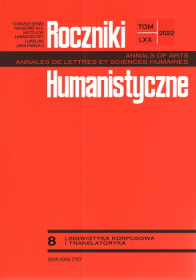Énoncés définitoires directs français et leurs équivalents lituaniens et polonais dans le corpus parallèle
French Direct Defining Statements and Their Lithuanian and Polish Equivalents in the Parallel Corpus
Author(s): Joanna Cholewa, Vita ValiukienėSubject(s): Language and Literature Studies, Translation Studies
Published by: Towarzystwo Naukowe KUL & Katolicki Uniwersytet Lubelski Jana Pawła II
Keywords: defining statement ; parallel corpus ; Lithuanian and Polish equivalents ; désigner ; signifier ; vouloir dire ; c’est-à-dire
Summary/Abstract: This article deals with defining statements containing the markers désigner, signifier, vouloir dire and c’est-à-dire. The linguistic data come from the parallel corpus of contemporary French-Lithuanian-Polish literary texts. The analysis focuses on the Lithuanian and Polish equivalents of the selected markers. We seek to know (1) what are these equivalents in the two languages of translation, and (2) if there are regularities in the translations of the statements with the selected markers. In the case of désigner, the Polish and Lithuanian translations retain the character of the defining statement, in which the sign→thing relationship is expressed. The interpretative relationship of defining meaning statements (the markers signifier and vouloir dire) is also mostly preserved in translation. However, the character of paraphrastic reformulation, present thanks to c’est-à-dire, is kept in Polish only in 3 cases of 19 with czyli. In Lithuanian, this relationship persists in 11 cases, thanks to two markers: tai yra and kitaip tariant.
Journal: Roczniki Humanistyczne
- Issue Year: 70/2022
- Issue No: 8
- Page Range: 95-108
- Page Count: 14
- Language: French

